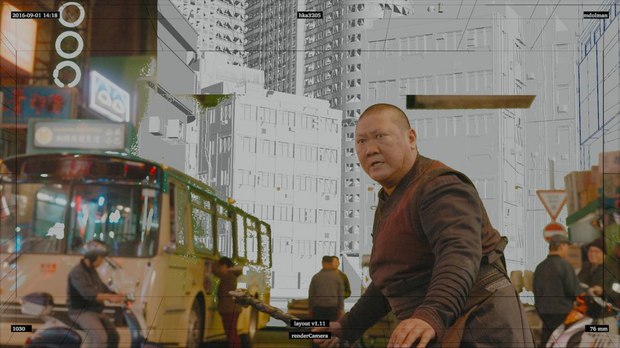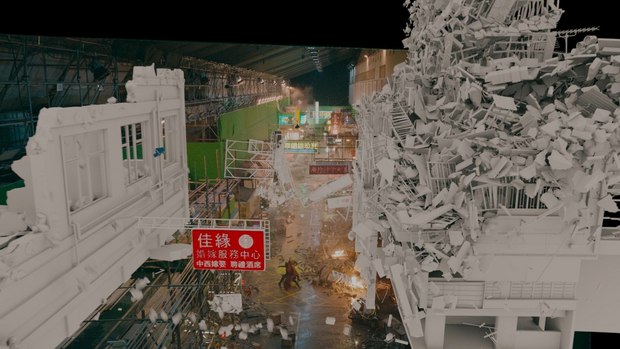VFX supervisor Richard Bluff describes Industrial Light & Magic’s dazzling New York and Hong Kong sequence work in Marvel’s supernatural adventure hit.
Doctor Strange, the 14th installment from the Marvel Cinematic Universe, opens up a world of new dimensions as our hero is forced to use his newfound magic skills to defend the world from the most powerful sorcerer in existence.
The Disney release, which has grossed over $673 million worldwide, is directed by Scott Derrickson and stars Benedict Cumberbatch in the titular role. Released this past Nov. 4, it tells the story of world-famous neurosurgeon Dr. Stephen Strange, whose life changes forever after a horrific car accident robs him of the use of his hands. When traditional medicine fails him, he is forced to look for healing in an unlikely place – a mysterious enclave known as Kamar-Taj. He quickly learns that this is not just a center for healing but also the front line of a battle against unseen dark forces bent on destroying our reality. Before long, Strange – armed with newly acquired magical powers – is forced to choose whether to return to his life of fortune and status or leave it all behind to defend the world.
Among a list of accolades, the film was nominated for six VES awards, one Annie award, and an award from the Art Directors’ Guild, along with an Oscar nomination for best visual effects for lead visual effects supervisor Stephane Ceretti, ILM visual effects supervisor Richard Bluff, Luma Pictures VFX supervisor Vincent Cirelli and special effects supervisor Paul Corbould.
“Conceptually, the movie was very difficult to pull off because there were lots of things that Marvel had never tried before,” notes Ceretti. “In terms of technical challenges, we had quite a few, but the biggest challenge was to bring magic to the Marvel Cinematic Universe in a fresh and innovative way. We tried to push the concept very far so there was a lot of R&D to make the magic new and fresh and also [travelling between] dimensions. All of these things were conceptual challenges.”
Ceretti explains that the film had around 1,450 visual effects shots, and all of them were complex. The otherworldly nature of the film called for extensive previs and postviz, which was critical for production. The previs served as a guide for filmmakers in executing the scenes.
As the film’s lead visual effects supervisor, he oversaw artists at ILM, Framestore, Method and Luma, plus six other vendors.
Facing a six-month post schedule was also quite a challenge, given the volume of work, but Ceretti came on board in September 2014, 14 months before principal photography started, which gave him a significant window for prep time during pre-production.
According to Ceretti, key scenes were handled as follows: Method Studios in L.A. handled a sequence dubbed “the magical mystery tour” as the protagonists travel through different dimensions; Method Studios’ Vancouver facility handled the car crash as well as all of the work in Kathmandu, including set extensions; Luma handled the opening sequences, the sequences at the cathedral and the dark dimension, as well a section at the end when Doctor Strange meets Dormammu; Framestore handled the big fight sequences as well as the Sanctum Sanctorum and most of the Astral world.
In addition, ILM was responsible for roughly 300 shots. VFX supervisor Richard Bluff was brought on board soon after Ceretti joined the show to handle two of the film’s key sequences – the destruction and subsequent rebuilding of Hong Kong, and warping New York around portals as Strange battled Kaecilius and the zealots.
Bluff worked directly with ILM’s London VFX supervisor Mark Bakowski, who oversaw the majority of the Hong Kong sequence. In the sequence, Dormammu has arrived on Earth, destroying Hong Kong in the process. Strange uses his powers to dial back time, restoring the city.
“London had its own supervisory team on the ground, and they were largely executing the [shots],” explains Bluff. “I think the majority of the exploration was really on the characteristics, the motivations and the specifics of the destruction. We had to ensure that the rebuilding of the destroyed city in the background didn't draw attention away from the characters, and that it didn't feel too convenient on the in-and-out points of the shots…that we didn't have convenient reconstructions going on. There needed to be a flow across a large body of shots.”
Bluff describes how he would review footage daily from London and send notes back to Bakowski. “A couple of times a week we would sync up and view the shots together, and discuss any concerns or issues or things that we wanted to redirect. Considering how our studios are hooked up, it was fairly seamless.”
The scenes where Doctor Strange reverses the destruction of Hong Kong were a particular challenge, because, “the company’s pipeline is built around destroying buildings and cities, not putting them back together,” Bluff adds. “Reversing destruction wasn't something that we had a good handle on, so we had to kind of work around that particular problem. It kind of broke our pipeline.”
The mass duplication of geometry was something quite new for the company, at least on this scale. Notes Bluff, “As we got into the postvis stage we were just kind of mashing the shots together in order to tell the story. My CG supe Doug Sutton then had to work double time with the software engineers to ensure that what we were coming up with visually was something that we could actually execute with high res assets once they actually flowed through the pipe to the TDs and animators.”
“I have a huge amount of respect for the work that those guys did,” he continues. “We [didn’t even realize] the challenges that they faced. It wasn't until we got to the end of the show and started reviewing how it went for everybody that we realized how much of the work was breaking new ground in terms of workflow pipelines between different departments.”
Meanwhile the majority of the New York sequence was executed by ILM’s team in Vancouver, while most of the assets were built in San Francisco. The warping effect was based on fractal geometry, which is inherently difficult to control, and required a lot of R&D to manipulate and choreograph.
“Very early on we knew that we would have to do some extensive postvis to swap out the previs assets with our real assets that were, obviously, component parts of New York,” explains Bluff. “And even at that early stage when we were just doing kind of gray shaded buildings, we knew that we would have to work with Marvel on finessing the compositions and movements within the scene to make sure that you understood the story now that the visual complexity was going up. So that's why we did the postvis in San Francisco, and also the vast majority of the asset builds in San Francisco -- we could quickly develop and turn around a version to the client that they could cut into their edit. They then would have confidence knowing that they had the story working while we then turned the shots over to Vancouver, and they continued on the lighting and the compositing, as we continued to upgrade the assets.”
Being in the same time zone, the artists in San Francisco could go over the dailies live every morning with artists in Vancouver. The screening rooms in both facilities are linked with video conferencing so the artists could have an open, real-time discussion as they moved through production.
“One of the areas where we did kind of push the limits of the technology was the postvis work, offering multiple versions of shots to the client in order to make sure that we weren't going crazy right out of the gate and losing the story,” says Bluff. “So we did several versions of postvis, giving them a simple, a medium and a more complex version.
“And then on top of that, in order to visualize and understand the vertigo and the sense of re-orientating the camera in shots, we actually modeled and 3D printed our own 360-degree camera rig for six Go Pro cameras that we then took on location to New York and slung off of the edge of Four World Trade Center,” he adds.
That footage was then stitched together inside a virtual reality experience back at ILM. “We invited the crew to effectively stand 12 feet out over the edge of a building several hundred feet above Manhattan to experience that sense of vertigo,” Bluff notes. “And in doing so, we actually started rotating their world, so they ended up standing on the side of a building to understand at what point you lose the sense of vertigo, or if it’s heightened by the motion. And then [we asked] how quickly we can move that camera. It became very useful in designing some of the shots in the movie.”
Bluff reports that the experience made a few people sick.
Speaking of the Oscar nomination, Bluff says, “The whole time working on this project, I never expected we would be in this position and it's incredibly humbling to be alongside so many amazing projects that have come out this year.”
“I think the first time I kind of opened my eyes to what this movie was going to be was the first screening,” he concludes. “Up until that point, I was just immersed in the sequences that we were doing at ILM. And by that point, you have little perspective on the work beyond executing and obviously fulfilling the client's requests and wishes. At the screening, I was actually pretty blown away by the work the other vendors were producing. Framestore, Luma, Method, everybody… I think, for me, that was the big ‘Wow’ moment.”
Scott Lehane is a Toronto-based journalist who has covered the film and TV industry for 30 years. He recently launched VRNation.tv -- an online community for VR enthusiasts.



















